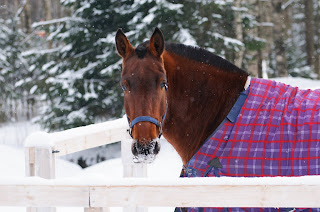Abdominal surgery is a major undertaking in horses, and not without significant risks to the patient. Colic operations, especially those that involve opening the gut wall, risk contaminating the wound with bacteria such that surgical site infection (SSI) is a potential complication.
Medical
grade honey (MGH) has been used successfully to treat established infections in
both humans and animals, and has been shown to improve wound healing of equine
lacerations and significantly reduce infection rate.
Would
the application of MGH help abdominal surgical wounds to heal?
A study
by Gustafsson and colleagues investigated whether medical grade honey gel,
applied on the linea alba during wound closure, would decrease the prevalence
of incisional infections in horses undergoing colic surgery.
The linea
alba is the fibrous band that runs along the midline of the belly, between the
abdominal muscles. Being composed of
fibrous connective tissue it contains no major blood vessels making it a
suitable site for incisions for abdominal surgery.
Figure 1: Example of intra-lesional application of
L-Mesitran Soft (MGH) following colic surgery
In this prospective randomized controlled trial, 108 horses that underwent colic surgery at Koret School of Veterinary Medicine in Israel were enrolled. Horses were randomized to control or treatment (MGH) group. In the treatment group, following closure of the linea alba, MGH gel (L-Mesitran Soft) was placed in the incision followed by routine closure of subcutaneous tissue and skin (Figure 1).
Horses were excluded from the study if they needed a
second abdominal surgery (n=4) or did not survive for at least two weeks
post-operatively (n=15).
The clinicians report that a single
intra-incisional application of MGH gel strongly reduced incisional infection
rate from 32.5% (13/40) in the control group to 8.2% (4/49) in the treatment
group (p=0.02).
No adverse reactions were observed
with the subcutaneous application of MGH after colic surgery.
A full report is published in the
Equine Veterinary Journal.
The authors conclude that intra-incisional
application of MGH gel on the linea alba is a simple and rapid procedure that
was safe and did not result in any adverse effects. A single local prophylactic
treatment with MGH in the abdominal incision during surgery significantly
decreased the prevalence of incisional infections in horses undergoing colic
surgery. They suggest that more research is necessary to explore this promising
approach in indications outside the equine colic field, e.g., in surgeries with
a high risk of SSIs.
For more details, see:
Intra‐incisional medical grade honey decreases the
prevalence of incisional infection in horses undergoing colic surgery: a
prospective randomised controlled study.
Gustafsson, K., Tatz, A.J., Slavin, R.A., Sutton, G.A.,
Dahan, R., Abu Ahmad, W. and Kelmer, G.
Equine Veterinary Journal (2020)
https://doi.org/10.1111/evj.13407
An
interview with Dr Gustafsson is available on YouTube:
























